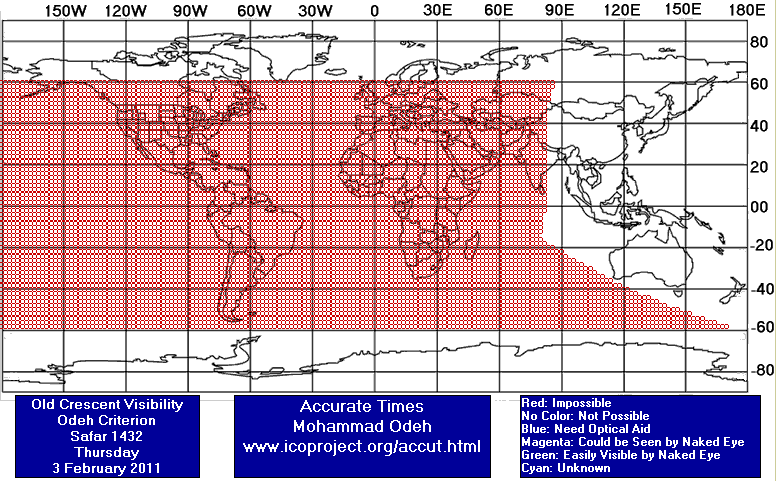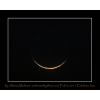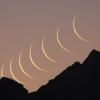Visibility of Rabee' Al-Awwal Crescent 1432 AH
- When to Observe Rabee' Al-Awwal Waxing (NEW) Crescent ?
- Rabee' Al-Awwal Waxing (NEW) Crescent Observation Results
- The OFFICIAL First Day in Different Countries
- When to Observe Safar Waning (OLD) Crescent ?
- Safar Waning (OLD) Crescent Observation Results
When to Observe Rabee' Al-Awwal Waxing (NEW) Crescent ?
The geocentric conjunction (Geocentric New Moon) will occur Inshalla on (Thursday 03 February 2011) at 02:31 UT.
Sighting the new crescent on (Thursday 03 February 2011) and (Friday 04 February 2011) is shown in the below graphs using the program Accurate Times by Mohammad Odeh according to Odeh criterion. Where:-
- It is impossible to see the crescent from the areas located under the red color. Because either the Moon on this day sets before the Sunset and/or the topocentric conjunction occurs after the Sunset.
- The crescent is expected to be seen by optical aid only from the areas located under the blue color.
- The crescent is expected to be seen by optical aid from the areas located under the magenta color. In these areas the crescent could be seen by naked eye if the atmospheric conditions are superb and the observer is experienced.
- The crescent is expected to be easily visible by naked eye from the areas located under the green color.
- The crescent cannot be seen from uncolored areas, even though the Moon sets in these locations after the Sunset and the topocentric conjunction occurs before the Sunset, but the Moon is not sufficiently illuminated in order to be seen as crescent even by optical aid.
- Kindly notice that the below graph shows the possibility of seeing the crescent from areas between 60 degrees north of Equator down to 60 degrees south of Equator.


According to the Universal Hejric Calendar (UHC), which is based on the calculated crescent visibility, the start of this month in the Eastern Region will be on Friday 04 February 2011 and in the Western Region will be on Friday 04 February 2011. Kindly notice that the UHC is a pre-calculated calendar, which adopts a certain criterion to start the new Hejric month. Your country/organization might adopt different criterion to start the new Hejric month. So it is highly advised to read the UHC website before giving any judgment.
- Results of seeing the crescent, and the first day of the month in different countries will be added here Inshalla as we receive the reports from ICOP's members. If you wish to be a member in ICOP, or to know more about it, kindly click here.
Rabee' Al-Awwal Waxing (NEW) Crescent Observation Results
Thu 03 February 2011
Algeria
Mr. Hocine Chikh Aissa said: "21 observers were present in N'tissa station with two binoculars (7*50) and one telescope. The new crescent of Rabee Awwal 1432 was not seen by naked eye nor by binocular nor by telescope, the sky near the Western horizon was clear but the crescent was not seen. "
Ghana
Mr. Abdul-Aziz Anyang said: "As at sunset our local time, moon age was 15 hrs and some few minutes. Reports from the northern and upper west region also was negative. Insha-Allah with good weather conditions on the night of february 4th, the new crescent will be seen by all."
Malaysia
Norway
Mr. Milad Ali Ershaghi said: "Bismillah al Rahman al Rahim On Thursday, February 3, 2011 - Sunset time was 4:36pm and Moonset time was 5:34pm in Oslo, Norway. I looked for the moon between 5:21pm and 5:34pm from a high point near Røa with a good view of the sky - but was unable to see the moon."
Pakistan
Mr. Alam Sultan said: "On my request, nearly 100 persons (members of the moon-sighting committees of our institute "JAMIA-TUR-RASHEED" + my friends + their companions) tried to sight the moon at more than 20 places all over Pakistan but the moon could not be sighted, as it was astronomically expected tonight. Almost it was cloudy or hazy all over Pakistan. Note 1: Chairman of central official moon sighting committee of Pakistan mufti munee-bur-Rahman told me on my mobile phone that as he also did not receive any positive report countrywide therefore he announced officially that Friday 4 February is 30th Safar and Saturday 5 February 2011 is 1st Rabee-ul-Awwal 1432 in Pakistan. Note 2: After some days, inshaallah, a detailed report of this observation in Urdu will be available at www.esnips.com/web/moonnewsofjamiaturrasheed "
Saudi Arabia
Mr. Saleh Al-Saab said: "The crescent was only (4.5) degrees above horizon, and the sky was not so clear."
South Africa
United Kingdom
Eng. Qamar Uddin said: "On Thursday 3 February 2011 (29 Safar1432 AH) many people from throughout UK have attempted to sight the crescent moon (Hilal) of Rabi-ul Awwal after sunset. None of the groups were able to sight the Hilal as most places were cloudy. We have not received any reliable sighting news from countries east of UK or Morocco either. Therefore, the Ulama (including Wifaq/Batley) have decided that the month of Safar 1432 AH will complete 30 days and the month of Rabi-ul Awwal 1432 AH will start from Saturday 5 February 2011, Insha-Allah."
United States
Dr. Javad Torabinejad said: "This evening (Thursday, February 03, 2011), it was cloudy here in Blacksburg, VA and thus the moon could not be sighted. I arrived at my sighting location before sunset and stayed till 6:00 pm (moonset: 6:38 pm)."
Eng. Mohammad Rahman said: "I tried to see the crescent moon with bare eyes for more than 30 minutes but it was not seen. The sky was completely cloudy and looked dark."
Fri 04 February 2011
Bangladesh
Mr. ABM Ruhul Hassan said: "People have seen the crescent from different parts of the country. Western sky was clear."
Germany
Eng. Martin Elsaesser said: "The 38h old crescent could be easily seen with the naked eye after sunset, despite approaching clouds. The view in some binoculars was even nicer."
Iran
Mr. Alireza Mehrani said: "Observation Report New Moon = = = = = = Location: Esfahan, Iran Latitude: 32° 37' N Longitude: 51° 35' E Elevation: 1619 meters from sea level Time zone: +3.5 Observer & photographer: Alireza Mehrani Date: Friday February 4, 2011 (Bahman 15, 1389) Temperature: 2.8 C° (37 F°) Wind: Calm Humidity: 42% Barometer: 842.9 mb Visibility: 10 km Topocentric and local time values from "Moon Calculator" (Refrac off): File name: amehrani-feb 2011-new.jpg Time: 18:24 LT (14:54 UT) Moon Alt: 6° 30' 13" Sun Alt: - (9° 58' 20") Elongation: 16° 28' 42" Rel Azi: 0° 18' 15" Moon Width: 0.61' Moon Phase: 2.29% Moon Age: 36h 22m after conjunction "
Pakistan
Mr. Alam Sultan said: "Alhamdolillah, today (Friday 4 February 2011= 30 Safar 1432 in Pakistan), we easily sighted the moon in Karachi and in many parts of country, as it was expected tonight astronomically. I requested many members of the moon-sighting committees of our institute "JAMIA-TUR-RASHEED" and many of my friends all over Pakistan to sight the moon. Nearly one hundred Persons easily sighted the moon at more than 13 places in 3 provinces (Balochistan, Sindh and Punjab). As it was fully cloudy or rainy in province Sarhad therefore there is no positive report from there. Note : After some days, inshaallah, a detailed report of this observation in Urdu will be available at www.esnips.com/web/moonnewsofjamiaturrasheed "
United Arab Emirates
Eng. Mohammad Odeh said: "Myself along with Prof. Nidhal Guessoum and our families were able to see the crescent easily by naked eye after sunset. "
United States
Dr. Javad Torabinejad said: "This evening (Friday, February 04, 2011), because of an overcast sky condition in Blacksburg, VA, no crescent sighting was possible; I checked the horizon at 6:00 pm (sunset: 5:49 pm EST and moonset: 7:36 pm)."
The OFFICIAL First Day in Different Countries
Fri 04 February 2011
1 . Algeria
2 . Bahrain
3 . Egypt
4 . Indonesia
5 . Jordan
6 . Kuwait
7 . Malaysia
8 . Palestine
9 . Qatar
10 . Saudi Arabia
11 . United Arab Emirates
12 . United States
Sat 05 February 2011
1 . Bangladesh
2 . Ghana
3 . Iran
4 . Morocco
5 . Oman
6 . Pakistan
7 . South Africa
8 . United Kingdom
9 . United States
When to Observe Safar Waning (OLD) Crescent ?
The geocentric conjunction (Geocentric New Moon) will occur Inshalla on (Thursday 03 February 2011) at 02:31 UT.
Sighting the OLD crescent on (Thursday 03 February 2011) and on (Wednesday 02 February 2011) is shown in the below graphs using the program Accurate Times by Mohammad Odeh according to Odeh criterion. Where:-
- It is impossible to see the OLD crescent from the areas located under the red color. Because either the Moon on this day rises after the Sunrise and/or the topocentric conjunction occurs before the Sunrise.
- The crescent is expected to be seen by optical aid only from the areas located under the blue color.
- The crescent is expected to be seen by optical aid from the areas located under the magenta color.. In these areas the crescent could be seen by naked eye if the atmospheric conditions are superb and the observer is experienced.
- The crescent is expected to be easily visible by naked eye from the areas located under the green color.
- The crescent cannot be seen from uncolored areas, even though the Moon rises in these locations before the Sunrise and the topocentric conjunction occurs after the Sunrise, but the Moon is not sufficiently illuminated in order to be seen as crescent even by optical aid.
- Kindly notice that the below graph shows the possibility of seeing the crescent from areas between 60 degrees north of Equator down to 60 degrees south of Equator.


Safar Waning (OLD) Crescent Observation Results
Tue 01 February 2011
Germany
Eng. Martin Elsaesser said: "The crescent could easily be seen with the naked eye some 44hours before conjunction. Due to fog and clouds in the lowlands i had to drive to the alps, but was rewarded with very clear skies and somewhat higher temperatures (only -8°C). The local ski slopes were still being prepared, which created some nice ice-clouds to look at. Luckily, these were below my position. I took series of images of the rising crescent and combined some of them to show the movement."
Wed 02 February 2011
Germany
Eng. Martin Elsaesser said: "The very difficult old crescent of 2. February was again observed from the mountains, due to fog in the lowlands. Weather conditions were very good. At 9° elongation and -19h age, the crescent could easily be observed with the established video-technique. The view was initially blurred by air currents near the horizon, but soon cleared as the crescent rose higher, showing a very fine arc. The crescent could easily be followed till after sunrise. I could NOT see the crescent visually this time with a pair of 20x60 binoculars. At these elongations, it probably needs higher magnifications. I will try on the young crescent tomorrow, weather permitting. "
Ghana
Mr. Abdul-Aziz Anyang said: "The weather conditions was hazy and the waning crescent was not seen."
Iran
Mr. Alireza Mehrani said: "Observation Report Old Moon = = = = = = Location: 33pol Bridge, Esfahan, Iran Latitude: 32° 38' 41.54" N Longitude: 51° 39' 54.11" E Elevation: 1570 meters from sea level Time zone: +3.5 Observer & photographer: Alireza Mehrani Date: Wednesday February 2, 2011 (Bahman 13, 1389) Temperature: -0.2 C° (31.6 F°) Wind: Calm Humidity: 75% Barometer: 839.1 mb Visibility: 15 km Topocentric and local time values from "Moon Calculator" (Refrac off): Crescent first observation through 7x50 binoculars: Time: 06:30 (03:00 UT) Moon Alt: 1° 55' 12" Sun Alt: - (6° 23' 50") Elongation: 10° 35' 19" Rel Azi: 6° 33' 51" Moon Width: 0.26' Moon Phase: 0.98% Moon Age: 23h 31m before conjunction Crescent last observation through 5x70 binoculars: Time: 06:43 (03:13 UT) Moon Alt: 4° 22' 19" Sun Alt: - (3° 46' 39") Elongation: 10° 30' 08" Rel Azi: 6° 37' 48" Moon Width: 0.25' Moon Phase: 0.96% Moon Age: 23h 18m before conjunction "
United States
Mr. Jim Stamm said: "Old Moon Crescent Observation Report ====================================== Observed: Wednesday; February 02, 2011 - 06:57 (Local) Location (WGS 84) = Tucson, Arizona (USA) Longitude = 110.71 W Latitude = 32.36 N Elevation = 2003 meters Time Zone = -7.0 hours Surface conditions at location: Temperature = -13 °C Humidity = 51 % Transparency seemed to be a problem, all of the way from the valley to the observing site. Magnitude limit at <1 degrees altitude with 55 power in C-8 telescope, before onset of twilight = 8.0 Topocentric and local time values from “Accurate Times”: Moonrise (at sea level) = 06:42 Sunrise (at sea level) = 07:08 Time from new moon at 06:57 = 14 hr. 03 min. Moon lag time = 26 min. Relative Altitude = 5.2 degrees Elongation from sun = 5.7 degrees Crescent width = 5 arc seconds Illumination = 0.25 percent I was NOT able to see the crescent, even through a telescope. Nearly 100% certain of aim and focus (although the focus was difficult because of the translucent sky). Sky looked superb, but apparently the humidity caused absorption. I followed the Moon’s location up and above the reddish horizon for a couple of degrees, but without success. Observer: Jim Stamm E-mail Address: StammJim@gmail.com"
















